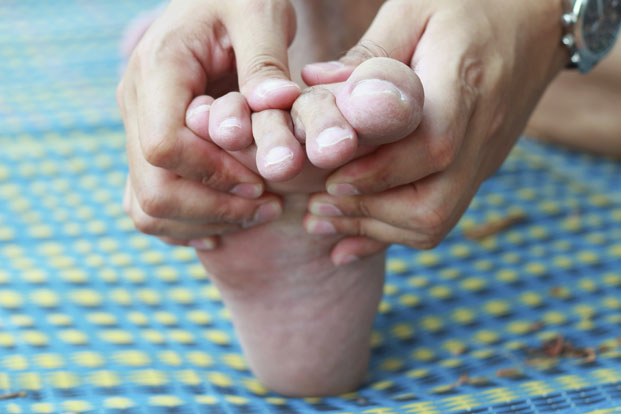It comprises 26 bones, 42 muscles, 56 ligaments and 33 joints, and every day it supports hundreds of tons of force. Your feet handle a lot of the body’s daily stress, carrying all of our weight (and the weight we choose to carry) and working with hundreds of combinations of muscles, bones, ligaments and tendons to get us where we need to go. It’s no wonder that they are at a high risk of injury and that our foot pain takes on many forms, from many sources.
About 40 percent of adults in the United States experience foot problems. These problems can lead to foot pain that may be disabling in scale and can impact nearly every aspect of our lives, from walking to driving. And this pain can be caused by external influences — like choosing to wear ill-fitting shoes or unstable stilettos — or problems with the internal structures of the foot, which can be inherited or affected by injury or disease. How and when you experience pain, along with visible signs, can help provide clues as to the cause of your foot pain.
There are countless causes of foot pain, but most fall into the following categories:
Skin Conditions
Skin conditions that can cause foot pain can include calluses and corns, which are skin conditions characterized by the thickening of the skin on a part of the foot from friction or pressure. Calluses typically appear on the balls of the feet or the heels, whereas corns appear on the toes. Ingrown toenails, a condition that occurs when the edges of the nail grow into or through the skin, can result in painful irritation and sometimes infections.
Infections
Infections vary widely in scale and cause. Fungal infections, such as the infection that causes athlete’s foot, are typically not dangerous unless you have a condition like diabetes. However, they can be difficult to treat once contracted and can lead to secondary, bacterial infections.
Warts, caused by a viral infection, are a common foot condition. While warts may occur on any part of the foot, warts that grow on the soles of the feet, a result of the viral infection taking hold in an often-unnoticeable cut or abrasion on the bottom of the foot, are called plantar warts. These warts can cause a powerful, burning pain when weight is put on them.
Musculoskeletal Conditions
The most common musculoskeletal condition affecting feet is a condition called plantar fasciitis. This condition occurs when the tissue – called the plantar fascia – that connects the heel bone to the toes becomes irritated and inflamed. The most common symptom of plantar fasciitis is an intense pain when weight is put on the foot, typically early in the morning.
Neurological Conditions
With so many nerves in the feet, neurological conditions are common. Conditions like small fiber neuropathy are increasingly recognized as major causes of painful, burning sensations in the feet, and can result from diseases like diabetes, impaired glucose tolerance and HIV, among other conditions. Morton’s neuroma, another neurological disorder, is a non-cancerous growth or thickening of nerve tissue in the foot. This growth occurs most typically between the third and fourth toes and can cause a sharp, burning pain in the ball of the foot.
The counterpart of carpal tunnel syndrome is another common form of neurological foot pain. Focal entrapment, a condition that occurs when a nerve is chronically compressed or mechanically injured at a specific location, can cause chronic foot pain. This condition is also called tarsal tunnel syndrome.
Bone Conditions
There is a wide range of bone conditions and deformities that can cause chronic foot pain. Among them:
Arthritis: Arthritic conditions, particularly those stemming from osteoarthritis and gout, can cause severe, chronic foot pain. Some conditions, like gout, are characterized by painful flare-ups while others may be characterized by more consistent foot pain.
Osteoporosis: Osteoporosis, a condition in which bone density loss occurs, can result in chronic foot pain.
Stress Fractures: Stress fractures are tiny cracks in a bone caused by the repetitive application of force, often because of overuse. Many people who suffer stress fractures are either athletes or suffer from occupational injuries.
Bunions: Bunions are a joint deformity of the big toe, which causes a bony protrusion at the base of the toe that can become inflamed. While many people are genetically pre-disposed to bunions, this condition may be caused or aggravated by wearing ill-fitting, tight shoes or high heels.
Bony Feet: Some people are born lacking sufficient padding in the soles of their feet — a condition called bony feet, which can make their feet more painful.
Vascular of Circulatory Conditions
The most common of these is a condition known as peripheral artery disease, or PAD. PAD is a common circulatory problem characterized by narrowed arteries, which reduce blood flow to the limbs. This condition can cause sufferers to have chronic pain when walking.
Many times, it’s not just one, but a combination of causes that can lead to chronic foot pain. These conditions can be exacerbated by our choices in footwear (which can range from your favorite pair of Jimmy Choos to your basic, poor-supporting flip flops or strappy sandals), exercise (or lack thereof), or from spending too much time on your feet (as is common in certain professions, from nursing to teaching). If you find yourself developing chronic foot pain, it’s important to make an appointment with your primary care physician or a foot specialist, called a podiatrist, who can help you diagnose your problem and develop a treatment plan that will reverse or minimize the damage caused by your particular ailment.
It’s important to note that many causes of foot pain are progressive, so early detection and treatment is essential to avoiding permanent damage or having to undergo surgical treatment methods. Don’t delay seeking help or you will risk limiting your mobility over time.

Leave a Reply